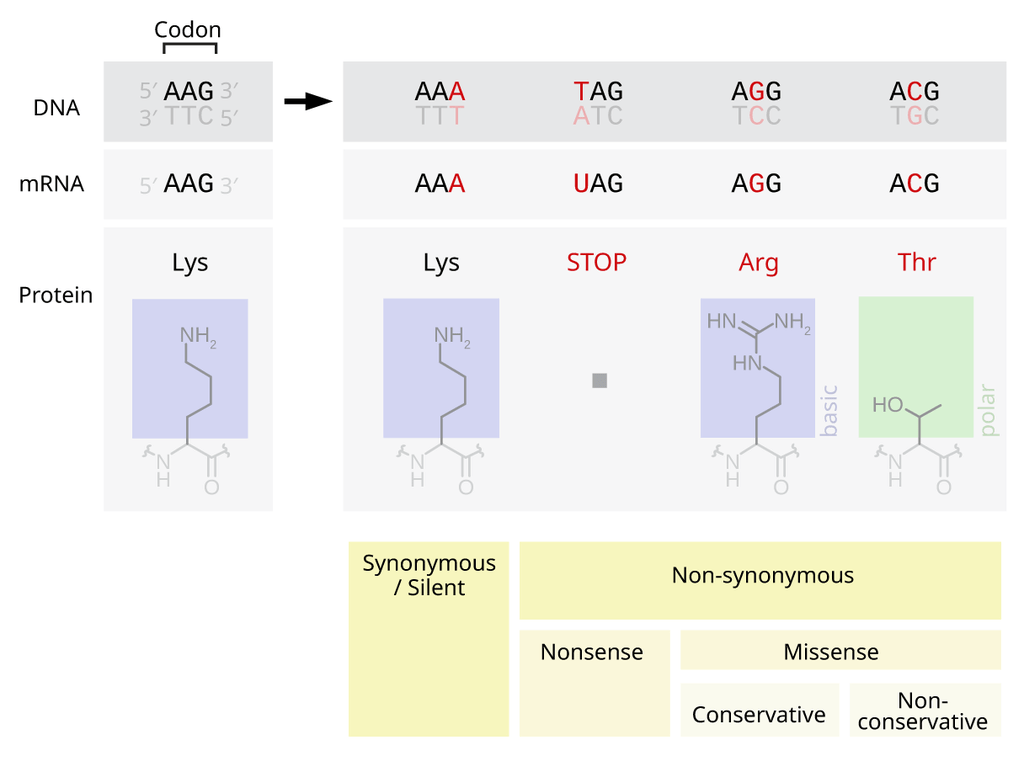What We Review
Introduction
Mutations are the driving force behind genetic variation, acting as catalysts for both evolutionary change and genetic disorders. In AP® Biology, understanding the “types of mutations” (or “types of DNA mutations”) is crucial because it connects directly to concepts like gene expression, heredity, and evolution. In this review, we’ll walk through the various forms of mutations, discuss their causes, and explore how they affect both our genotype (genetic makeup) and phenotype (observable traits).
Understanding Mutations
A mutation is any permanent change in the DNA sequence. These changes can occur in a single base pair or involve large sections of a chromosome.
- Genotype vs. Phenotype: The genotype is the genetic code that carries the instructions for traits, while the phenotype is the physical manifestation of these traits. Mutations can alter the genotype, sometimes leading to noticeable changes in phenotype.
- Role in Genetic Variation: Mutations introduce new alleles into a population, driving diversity and potentially supplying the raw material for evolution by natural selection.
Types of Mutations

- Point Mutations
- Point mutations involve changes to a single nucleotide in a DNA sequence. Despite their small scale, they can have significant impacts on protein structure and function.
- Silent Mutations: The altered nucleotide still codes for the same amino acid, so there is no observable effect on the protein. They are often deemed “neutral.”
- Missense Mutations: A single nucleotide change results in a different amino acid being incorporated into the polypeptide chain. This can alter the protein’s structure and function, sometimes leading to diseases.
- Nonsense Mutations: A codon is changed to a “stop” codon prematurely, halting translation. This often leads to a shortened, nonfunctional protein.
- Point mutations involve changes to a single nucleotide in a DNA sequence. Despite their small scale, they can have significant impacts on protein structure and function.
- Insertions and Deletions
- Insertions and deletions (commonly called “indels”) involve adding or removing nucleotides from the DNA sequence.
- Frame Shifts: When the number of inserted or deleted nucleotides is not a multiple of three, it shifts the reading frame of the gene. This can drastically change the amino acid sequence downstream and often produces a nonfunctional protein.
- Consequences and Examples: Cystic Fibrosis can be caused by a three-nucleotide deletion (removing a single amino acid). Even a small insertion or deletion can lead to severe disorders if it disrupts critical genes.
- Insertions and deletions (commonly called “indels”) involve adding or removing nucleotides from the DNA sequence.
- Large-Scale Mutations
- These mutations affect large sections of chromosomes, thereby having the potential to alter the overall chromosome structure and function.
- Duplications: A segment of the chromosome is repeated, potentially increasing the gene dosage.
- Inversions: A chromosome segment breaks off, flips, and reattaches in reverse order, which can affect gene regulation.
- Translocations: Parts of two different chromosomes swap places. Translocations can lead to various disorders if they disrupt essential gene sequences or regulatory regions.
- These mutations affect large sections of chromosomes, thereby having the potential to alter the overall chromosome structure and function.
Causes of Mutations
- DNA Replication and Repair Errors: Mistakes can occur during DNA replication, especially if errors are not caught and corrected by DNA repair mechanisms.
- Environmental Factors: Certain chemicals, radiation, and viruses can damage DNA, causing mutations. These are often referred to as induced mutations.
- Spontaneous vs. Induced: Spontaneous mutations arise from natural errors in biological processes, while induced mutations result from external environmental factors such as ultraviolet light or carcinogenic substances.
Mutations During Meiosis
Meiosis is the specialized type of cell division responsible for producing gametes (sperm and eggs). Errors here can have significant consequences for offspring.
- Nondisjunction and Chromosomal Changes
- Nondisjunction is the failure of chromosome pairs to separate properly during meiosis.
- Effects: This can lead to abnormal numbers of chromosomes in offspring, known as aneuploidy.
- Examples: Down syndrome (Trisomy 21) results from an extra copy of chromosome 21. Turner syndrome (45, X) occurs when a female has only one X chromosome.
- Nondisjunction is the failure of chromosome pairs to separate properly during meiosis.
- Genetic Variation from Meiosis
- Gene Shuffling: Crossing over and independent assortment create genetic diversity.
- Mutations and Variation: When mutations are introduced during meiosis (for example, errors in crossing over), they can be passed on to future generations, contributing to the overall genetic variation in a population.
Consequences of Mutations
- Positive, Negative, or Neutral Effects: While some mutations cause harmful disorders, others are neutral or even beneficial, potentially offering an advantage and promoting evolutionary change.
- Role in Natural Selection: Mutations that improve an organism’s survival or reproductive success are more likely to spread through populations over generations.
- Environmental Context: Whether a mutation is advantageous, deleterious, or neutral can depend on the surrounding environment.
Conclusion
Understanding the different types of mutations—from single-nucleotide changes to large-scale chromosomal rearrangements—reveals how delicate the link is between genetic code and expressed traits. For AP® Biology students, grasping the causes, mechanisms, and outcomes of these mutations is fundamental, not only for exam success but also for appreciating the dynamic nature of genetics and evolution.
By combining a clear understanding of mutation types, their causes, and their biological significance, you’ll be well-prepared to tackle AP® Biology questions on genetics and evolution. Remember, studying specific examples of genetic disorders or beneficial mutations can also help you see how these concepts apply in real-life contexts!
Sharpen Your Skills for AP® Biology
Are you preparing for the AP® Biology test? We’ve got you covered! Try our review articles designed to help you confidently tackle real-world math problems. You’ll find everything you need to succeed, from quick tips to detailed strategies. Start exploring now!
Need help preparing for your AP® Biology exam?
Albert has hundreds of AP® Biology practice questions, free response, and full-length practice tests to try out.








